ATTO Disk Benchmark
The ATTO disk benchmark is a Windows-based utility for testing storage performance of any storage drive or controller. We use the default benchmark setup.
M.2 PCIe Performance
For M.2 testing we use a Toshiba OCZ RD400 256GB M.2 PCIe NVMe SSD.
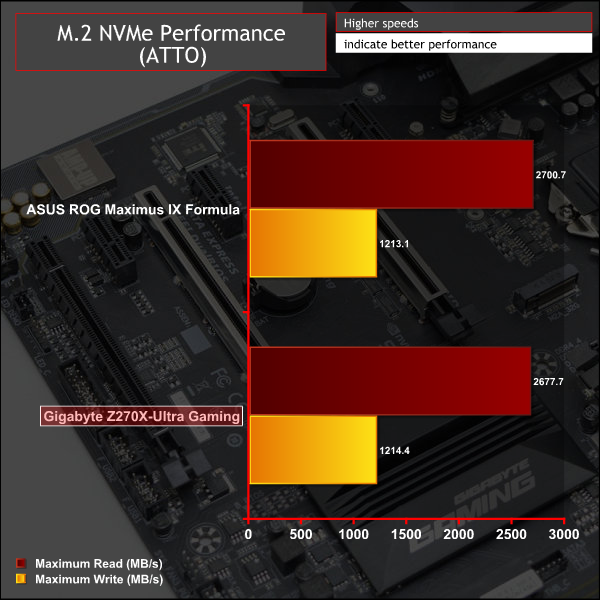
The peak M.2 NVMe throughput was as expected for the 32Gbps connection enabled by this motherboard. Thermal throttling was fairly minimal since the M.2 SSD caught some of the airflow off the graphics card and CPU cooler because of its central and open location.
However, over a longer period of sustained use, thermal throttling started to occur more frequently so Gigabyte should consider a way of dealing with heat from M.2 devices. Modern computer cases with strong internal airflow should be able to mitigate the heat for the most part.
USB Performance
We test USB 3.0 and 3.1 performance using a pair of Transcend SSD370S 512GB SSDs in RAID 0 connected to an Icy Box RD2253-U31 2-bay USB 3.1 enclosure powered by an ASMedia ASM1352R controller.
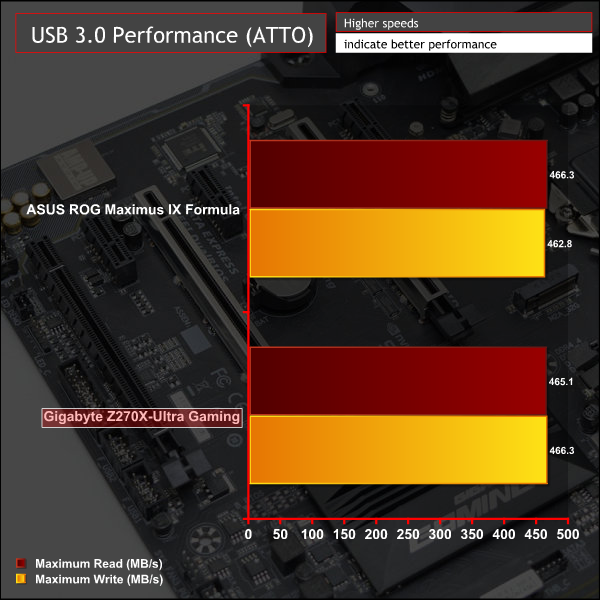
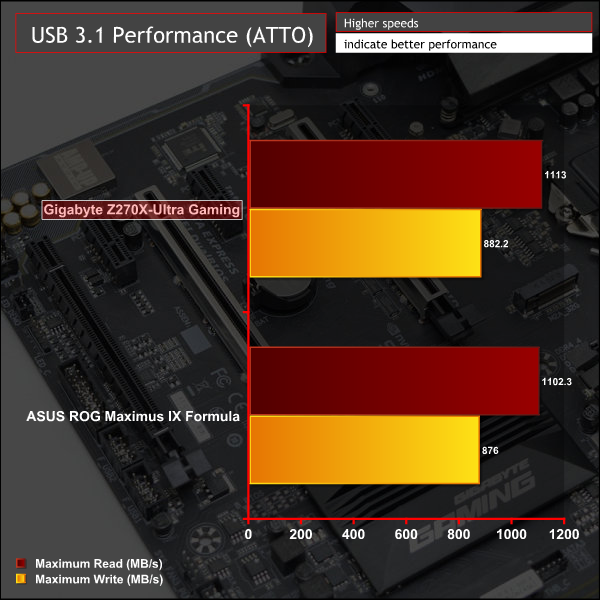
USB performance is typical for the controllers used, Intel Z270 and ASM2142, on both the USB 3.0 and 3.1 interfaces, respectively.
SATA 6Gbps Performance
For SATA 6Gbps testing we use an OCZ Trion 150 480GB SSD.
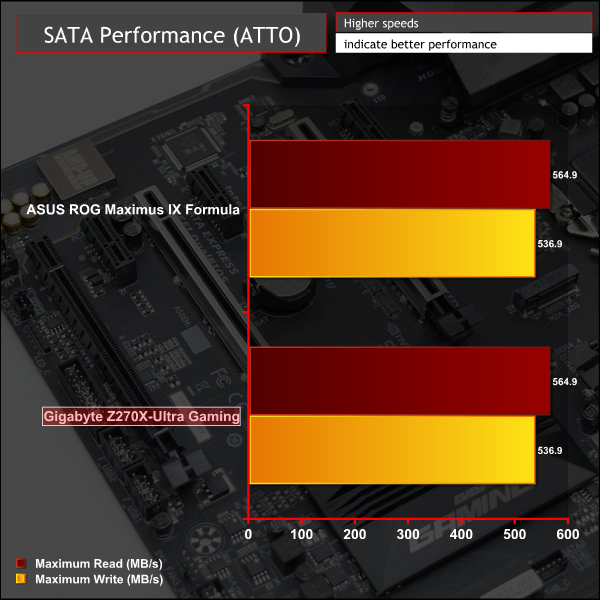
SATA performance is par for the course.
Audio
Rightmark Audio Analyser is a freeware benchmarking utility designed to objectively test the performance characteristics of audio solutions. We setup a line-in line-out loop and execute the record/playback test before generating the results report you see below. A sampling mode of 24-bit, 192 kHz was tested.
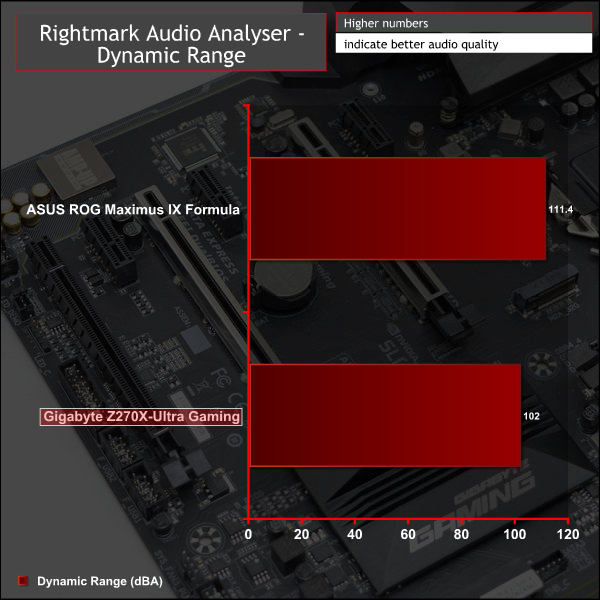
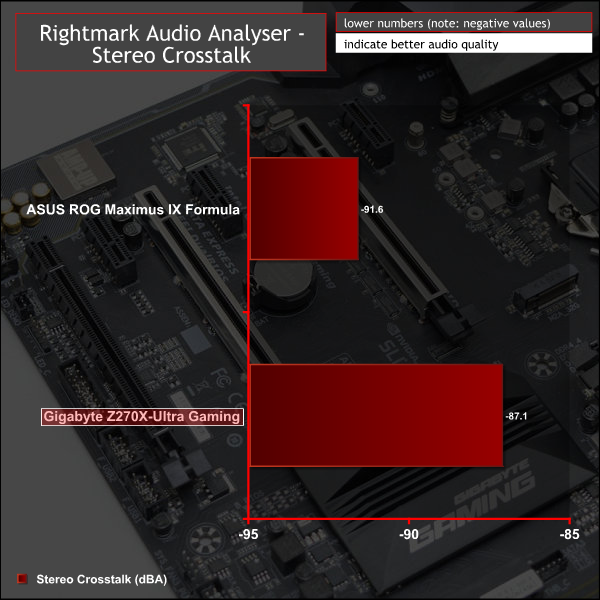


Audio performance is Excellent across the board which reflects the latest Realtek ALC 1220 codec being utilised by Gigabyte's audio implementation. Gigabyte's Z270X-Ultra Gaming didn't perform as well as the Maximus IX Formula (which is a much more expensive motherboard and uses many more audio components), but the results recorded are stronger than many Z170-generation motherboards running what used to be the best codec prior to Z270's release, Realtek ALC 1150.
 KitGuru KitGuru.net – Tech News | Hardware News | Hardware Reviews | IOS | Mobile | Gaming | Graphics Cards
KitGuru KitGuru.net – Tech News | Hardware News | Hardware Reviews | IOS | Mobile | Gaming | Graphics Cards


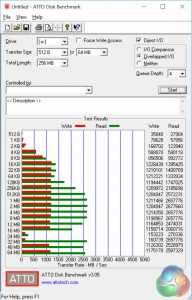
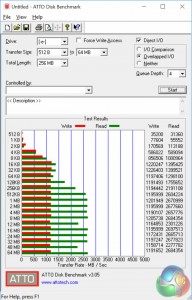
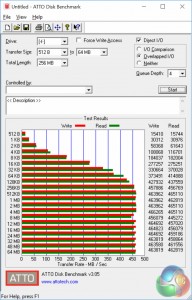
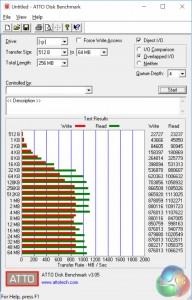
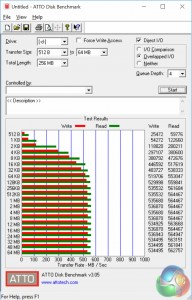

I think I’m over with all these hardwares. The customer service is rubbish left, right, up and down, vendors and manufacture alike, MSI, Samsung the list goes on… I lost a M.2 screw, and MSI’s support could care less.
Hello Ryan
I’ve just bought this board for my new build. Do you think there’s a way to make the auto voltage function less aggressive?
Thanks 🙂
Hey, you could apply a core voltage offset. I discussed it at the bottom of the UEFI page. I found that -0.1 was enough to keep power down and was still perfectly stable. You may be able to get a lower voltage yourself (-0.1 to -0.2) depending on your CPUs capability. You could also choose a lower LLC setting instead of the Auto LLC setting. The core voltage offset is under MIT-CPU Core Voltage Control, if you leave the core voltage as auto then do the dynamic vcore option (use + and – on the keyboard to get down to -0.1, it’s a bit fiddly). MIT-Advanced Power Options has the LLC setting. Medium or lower should keep the voltage a bit less aggressive but the offset will be the most effective way.
Gigabyte may well alter the voltage behaviour with BIOS updates too so keep an eye out! Also be sure to have the “balanced” windows power profile to get adequate clocking/voltage down for less intensive tasks.
Alright, thanks for the tips!
I’ll make sure to look out for future updates.
The correct screw size is 2.0 x 3mm (CM2x3-3.3)
should be available at hardware / electronics stores.
Thanks for the suggestion, I’ve gone to two electronics stores specialising in screws, nuts and bolts, none of them has anything remotely as small as the M.2 screws. Hope, some manufacturers in computers parts will make them for sale in the future.
Isn’t that audio test pretty seriously flawed? If you do loop back the results are only as good as the line in ADC is and doesn’t really tell anything about the line out DAC quality. Judging by Realtek ALC1220 specs it has much worse line in than line out quality.
Can i run my I7 6700K on this Board?
yes
I see the F4 Bios has ‘V-Core Voltage Adjust’ has anyone used this and did it correct the high auto voltage issue?
Really? This board gets a 8 / 10 when by the picture it looks like it has a craptacular 7 phases? Combine that with the UEFI layout issues, bad auto voltages and thats plenty to bring it down to a 7 / 10.
Stop kissing Gigabytes arse and rate things accordingly.
eu preciso aprender a configurar a memoria g.skil 3200mhz nessa placa. alguem pode me ajudar?
does this motherboard support NVME?
its about what’s said in the reviews, not about the ratings themselves.
the Written Reviews tell you a lot more then just some arbitrary subjective-rating.
an 8/10, 7/10 and even a 6/10 could have a lot different meanings and interpretations base on the person. Some people may not view a 8/10 not that highly while a 6/10 might be seen as a ‘good’ score, to some.
It’s all based on the person perception of the numbers. You can’t objectively score a product like a video-game for example.
That’s why its important to read the ACTUAL review, rather then just look at the Rating/awards given to it. To see what is actually said about the product and make an informed decision based on that, rather then trying to make a decision based off an arbitrary rating.
Fallout New Vegas for example got a 84 on metacritic, though in my opinion its one of best games of that year, even now in my opinion it still holds up quite well as a great game. That said, it got an 84 out of 100 for a score. Does Scoring really matter? It’s meant to give a generic-overall view of the game in simple terms. like “Great Game” or “Great Product”.
7/10, 10/10, 1/10, etc doesn’t matter. What matters is the content of the review, what they say about the product itself, how it runs, it feels, how it looks, features, how it compares to other products in its industry, etc. Don’t take the 8/10 to heart, too much just because you feel the score should be different. Numbers mean different things to different people, so an 8 is not always the “8” the way you may be perceiving it.
Yes, but will depend on how many PCIE lanes you are using and your CPU.
If i enter a value of 1-1.299 it will work and when i put 1.35 for example it switches the mode to AUTO and locks at 1.3
On page 10 of the first guide he specifies how he has a profile with 1.35 voltage and on the second link there are screenshots of him at 1.375
https://view.joomag.com/gigabyte-z270-overclocking-guide-gigabyte-200-series-overclocking-guide/0767815001483933769
http://www.kitguru.net/components/motherboard/ryan-martin/gigabyte-z270x-ultra-gaming-motherboard-review/4/
Is it because I am on version f6 of the BIOS or is my mobo simply locked @ 1.3?
In the first guide he also mentioned how he set his CPU Vcore Loadline Calibration to TURBO and I don’t have this setting available
Z270P-D3 + i7-7700k BIOS version f6